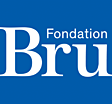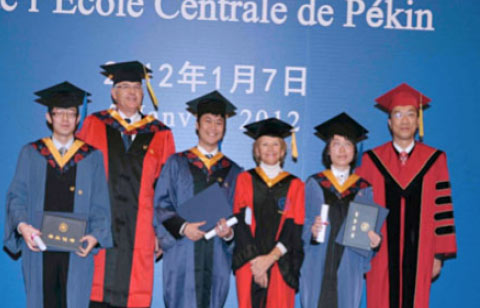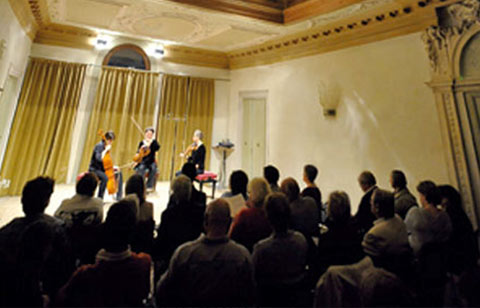
Casino Zane
Restoring a Venetian palazzetto
Nicole Bru, who is a great lover of Venice, was delighted to discover in 2006, away from the tourist track, the discreetly charming Casino Zane. She bought this seventeenth-century palazzetto with the ambitious aim of restoring it to its former glory and returning it to its original purpose as a place devoted to music.
A very special project
Dr Nicole Bru knows Venice well. She and her late husband, Jean Bru, always loved the city and felt that something should be done to reverse the ravages of time and preserve its unique atmosphere and everlasting character. Years later, having set her “sleuths” to find a building to restore in Venice, she fell under the spell of a small palace dating from the seventeenth-century.
This palazzetto, bearing the name of its original owners, the Zane family, was originally a place for entertainment, especially for listening to music. Captivated by this place steeped in history and set in a quiet part of Venice, which belonged at the time to Archduke Dominic of Habsburg. Dr Nicole Bru decided to buy it in 2006, with the prime intention of restoring it as closely as possible to its original appearance.
Rediscovering the past
The restoration of the palazzetto was carried out with the dual objective of respecting its history, while meeting the safety requirements for a building intended to receive the public.
It was therefore necessary first of all to trace the origins and the long history of the palazzetto, in order to rehabilitate the building in the spirit of the time. The artists who worked on the Casino Zane and its owners are part of Venetian history. The palazzetto is listed and therefore comes under the responsibility of the Soprintendenza per i Beni e Architettonici Paesaggistici di Venezia e Laguna. A study of documents in the Collato library (now in the Museo Correr) brought to light the following information:
- Built between 1695 and 1697, the Casino Zane housed the entertainments of the Zane family, before becoming a private residence at the end of the eighteenth century.
- The palazzetto was designed by the architect Antonio Gaspari (who is believed to have served his apprenticeship in the workshop of the famous Baldassare Longhena), then altered in 1708 by Domenico Rossi. It was decorated by famous artists, Abbondio Stazio (a master of stuccowork), Sebastiano Ricci and Fernandino Fochi (for the frescoes) and Andrea Brustolon (for the carved balustrade).
- Its previous restoration dated from the 1930s: modern amenities, such as central heating and sanitation, were installed in the palazzetto at that time without jeopardising the original. The palazzetto remains a beautiful example of a private home, with its elegant façade on the canal side and a private garden to the rear that is one of the few authentic Venetian gardens to have survived in the city.
Restoringwith the aim of reviving history
Marc Desportes, who knows Venice well, was technical advisor for the operation, steering this ambitious restoration project. He worked with the Marco Zordan firm of architects, selected by competition for the simplicity and elegance of its project, and its respect for the harmony and authenticity of the place.
The palazzetto, where Mozart is said to have played during his stay in Venice (Carnival, 1771), gradually recovered its original character and colours. Delicate work was accomplished to strengthen the building while maintaining the quality of the acoustics. Excavations on the ground floor, carried out by the archaeologists of the Soprintendenza per i Beni e Architettonici Paesaggistici di Venezia e Laguna, brought to light walls dating from the thirteenth century, and also shards of pottery and coins. Sounding detected the presence of frescoes beneath the surface of the walls; these, when revealed, proved to be magnificent.
The floor plan is traditional Venetian: the palace is centred on a magnificent concert hall, with a gallery running around it on the floor above. On the vaulted ceiling the visitor can admire a fresco (painted on canvas) by Sebastiano Ricci, showing Hercules between Glory and Virtue. Each of the corners of the vault is decorated with a pair of monochrome medallions depicting gods of Olympus. The four large shells, decorated with painted scenes, are very unusual for Venetian art. Visitors reach this room via a grand staircase decorated with a fresco, depicting Time carrying off Truth, also by Sebastiano Ricci, who painted the sets for several of Handel’s operas.
In eighteen months, this exceptional building was restored to its original purity; it recovered its soul. It was Dr Nicole Bru wish for it to be used for its original purpose, music, through the creation of the Palazzetto Bru Zane – Centre de musique romantique française. Music now resounds once more within its walls.
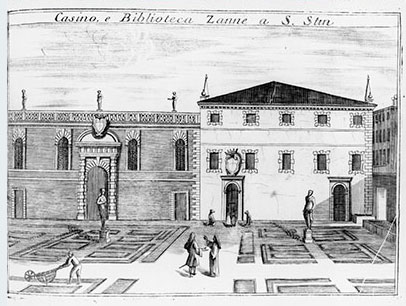
The Palazzo Zane. Engraving by Luca Carlevarijs – Le fabriche e vedute di Venetia
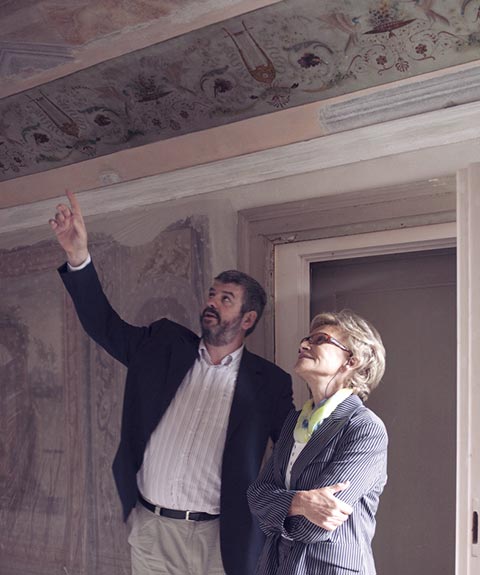
Dr Nicole Bru with the architect Marco Zordan
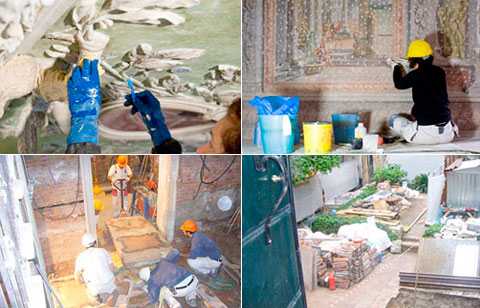
Restoration work on the Palazzetto Bru Zane
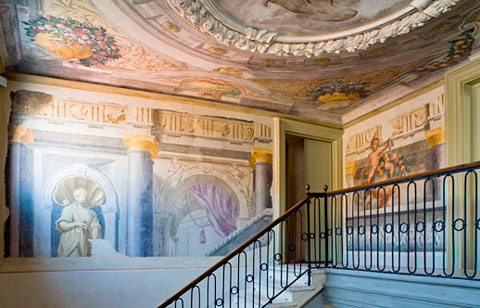
Frescoes of the Palazzetto Bru Zane after restoration
